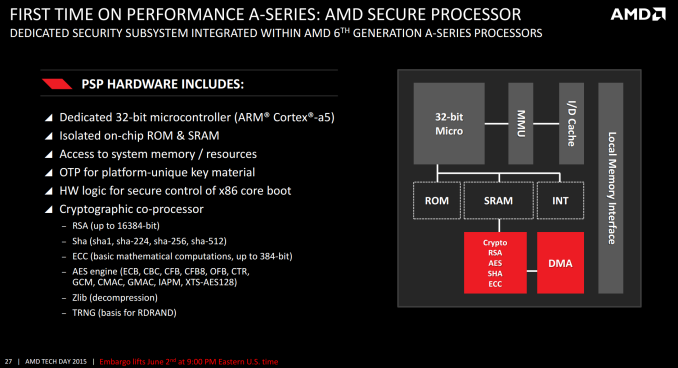AMD Launches Carrizo: The Laptop Leap of Efficiency and Architecture Updates
by Ian Cutress on June 2, 2015 9:00 PM ESTAMD Secure Processor
One of the final pieces in the puzzle is AMD’s Secure Processor, which they seemed to have called the PSP. The concept of the security processor has evolved over time, but the premise of a locked down area to perform sensitive work that is both hidden and cryptographically sealed appeals to a particular element of the population, particularly when it comes to business.
AMD’s PSP is based around a single 32-bit ARM Cortex-A5, with its own isolated ROM and SRAM but has access to system memory and resources. It contains logic to deal with the x86 POST process but also features a cryptographic co-processor.
ARM has been promoting TrustZone for a couple of years now, and AMD has been tinkering with their Secure Processor proposition for almost as long although relatively few explanations from AMD outside ‘it is there’ have come forward.
Final Thoughts
Sometimes a name can inspire change. Carrizo isn’t one of those names, and when hearing the words ‘AMD’s notebook processor’, those words have not instilled much hope in the past, much to AMD’s chagrin no doubt. Despite this, we come away from Carrizo with a significantly positive impression because this feels more than just another Bulldozer-based update.
If you can say in a sentence ‘more performance, less power and less die area’, it almost sounds like a holy trifecta of goals a processor designer can only hope to accomplish. Normally a processor engineer is all about performance, so it takes an adjustment in thinking to focus more so on power, but AMD is promising this with Carrizo. Part of this will be down to the effectiveness of the high density libraries (which according to the slides should also mean less power or more performance for less die area) but also the implementation of the higher bandwidth encoder, new video playback pathway and optimization of power through the frequency planes. Doubling the L1 data cache for no loss in latency will have definite impacts to IPC, as well as the better prefetch and branch prediction.
Technically, on paper, all the blocks in play look exciting and every little margin can help AMD build a better APU. It merely requires validation of the results we have been presented along with a killer device to go along with it, something which AMD has lacked in the past and reviewers have had trouble getting their hands on. We are in discussions with AMD to get the sufficient tools to test independently a number of the claims, and to see if AMD’s Carrizo has potential.











137 Comments
View All Comments
Novacius - Tuesday, June 2, 2015 - link
From the article: "However for a 15W part, to which Carrizo will be primarily, this means either a 10%+ power reduction at the same frequency or a 5% increase in frequency for the same power. Should AMD release other APUs in the 7.5W region, this is where most of the gains are."It's power per core pair (module) and Carrizo clearly has two of them. This means the highest gains are exactly in the 15W TDP range.
Ian Cutress - Tuesday, June 2, 2015 - link
Good point, article updated :)Novacius - Tuesday, June 2, 2015 - link
"The big upgrade in graphics for Carrizo is that the maximum number of compute units for a mobile APU moves up from six (384 SPs) to eight (512 SPs), affording a 33% potential improvement."Mobile Kaveri already has 8 CUs (FX-7600P), but only at 35W.
el etro - Tuesday, June 2, 2015 - link
They stated that the power savings allowed them to put the 512SPs/8CUs in the 15W part.Ian Cutress - Wednesday, June 3, 2015 - link
I changed that on the fly a little while back between meetings, should be OK now :)ClamShall - Tuesday, June 2, 2015 - link
This article is basically just an explanation of AMD's marketing slides without actual empirical data to back things up (other than what has been provided by AMD). Worse still, it doesn't make any notable attempt to critically analyze whether the company's claims will or will not materialize.In short, this article should've been left to AMD's marketing team and posted on the company's site.
Iketh - Tuesday, June 2, 2015 - link
I don't have time to visit multiple sites. This is the only one I visit. Thank you AT for this article and keep them coming please.KenLuskin - Wednesday, June 3, 2015 - link
clamboy, This is a good article, and you are just another Intel fanboy with butt hurt. Intel does the EXACT same thing, and yet dumbos like you suck it up...... Bend over and assume the position for maximum penetration!SolMiester - Wednesday, June 3, 2015 - link
Eh?, and how are AMD providing the butt hurt?....formulav8 - Sunday, June 7, 2015 - link
Because there are many wackos who feels like an Intel/NVidia Corp is their mommy and hates to see AMD improve anything. Look at comments for Freesync reviews and such. Stupid how anyone gets attached to a Corp who cares nothing about you.